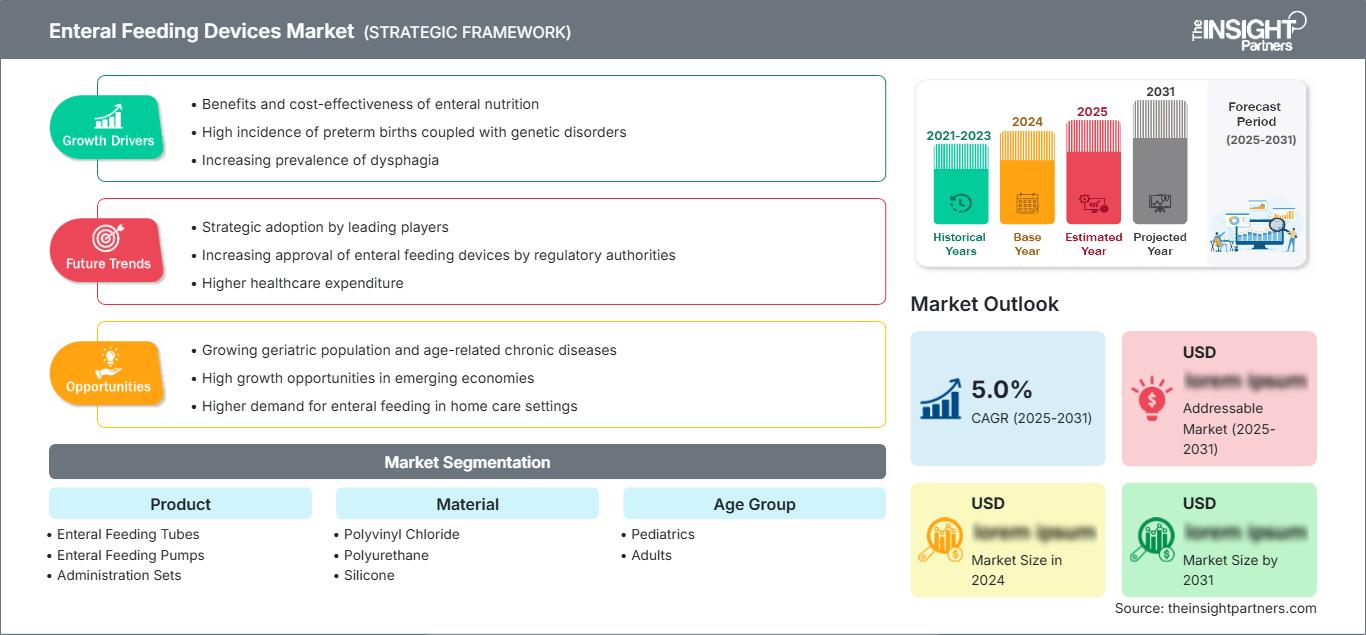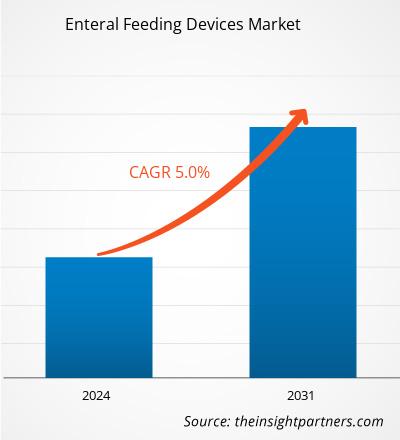Le marché des dispositifs de nutrition entérale devrait atteindre 7,08 milliards de dollars américains d'ici 2031. Il devrait enregistrer un TCAC de 5,9 % entre 2025 et 2031.
Le rapport est segmenté par type de dispositif de nutrition entérale (troubles anxieux, troubles liés à la consommation de substances, troubles de l'humeur et autres). Il présente également une analyse basée sur le matériau (chlorure de polyvinyle [PVC], polyuréthane et silicone), le groupe d'âge (pédiatrie et adultes), l'application (oncologie, maladies gastro-intestinales, troubles neurologiques, diabète, hypermétabolisme et autres applications) et l'utilisateur final (hôpitaux, centres de chirurgie ambulatoire et soins à domicile). L'analyse mondiale est ensuite ventilée par région et par principaux pays. Le rapport présente les valeurs en dollars américains pour les analyses et segments mentionnés ci-dessus.
Objectif du rapport
Le rapport L'étude de marché sur les dispositifs de nutrition entérale réalisée par The Insight Partners vise à décrire le paysage actuel et la croissance future, les principaux facteurs de croissance, les défis et les opportunités. Elle fournira des informations précieuses à divers acteurs du secteur, tels que :
- Fournisseurs de technologies/Fabricants : pour comprendre l'évolution de la dynamique du marché et identifier les opportunités de croissance potentielles, afin de prendre des décisions stratégiques éclairées.
- Investisseurs : pour réaliser une analyse approfondie des tendances concernant le taux de croissance du marché, les projections financières et les opportunités tout au long de la chaîne de valeur.
- Organismes de réglementation : pour encadrer les politiques et les activités du marché afin de minimiser les abus, de préserver la confiance des investisseurs et de garantir l'intégrité et la stabilité du marché.
Segmentation du marché des dispositifs de nutrition entérale : Produits
- Sondes de nutrition entérale
- Pompes de nutrition entérale
- Sets d'administration
- Seringues entérales
- Consommables
Matériaux
- Chlorure de polyvinyle
- Polyuréthane
- Silicone
Groupe d'âge
- Pédiatrie
- Adultes
Applications
- Oncologie
- Maladies gastro-intestinales
- Troubles neurologiques
- Diabète
- Hypermétabolisme
- Autres applications
Utilisateurs finaux
- Hôpitaux
- Centres de chirurgie ambulatoire
- Soins à domicile
Vous bénéficierez d’une personnalisation sur n’importe quel rapport - gratuitement - y compris des parties de ce rapport, ou une analyse au niveau du pays, un pack de données Excel, ainsi que de profiter d’offres exceptionnelles et de réductions pour les start-ups et les universités
Marché des dispositifs d'alimentation entérale: Perspectives stratégiques

- Obtenez les principales tendances clés du marché de ce rapport.Cet échantillon GRATUIT comprendra une analyse de données, allant des tendances du marché aux estimations et prévisions.
Facteurs de croissance du marché des dispositifs de nutrition entérale
- Avantages et rentabilité de la nutrition entérale : Elle consiste à administrer des nutriments directement dans le tube digestif aux patients incapables de les ingérer et de les absorber par voie orale. La croissance du marché de la nutrition entérale s’explique par ses multiples avantages et sa rentabilité. La nutrition entérale présente de meilleurs taux de guérison chez les patients souffrant de maladies chroniques ou hospitalisés, lorsque leur état nutritionnel est maintenu, voire amélioré.
- Forte incidence de naissances prématurées et de maladies génétiques : L’augmentation du nombre de naissances prématurées et de maladies génétiques chez les enfants et les nouveau-nés engendre une demande croissante en nutrition entérale. Du fait de leur faible poids de naissance, ces bébés prématurés ont des besoins nutritionnels plus élevés, leurs systèmes organiques étant moins développés. Il est donc essentiel de répondre à leurs besoins par une nutrition entérale adaptée. Pour les enfants atteints de troubles génétiques affectant la digestion et l'absorption, la nutrition entérale (NE) peut fournir une forme de nutrition plus digeste et de meilleure qualité, tout en assurant leur apport en nutriments essentiels.
- Prévalence croissante de la dysphagie : La dysphagie est beaucoup plus fréquente chez les personnes âgées, principalement en raison de pathologies liées à l'âge telles que les accidents vasculaires cérébraux, les maladies neurologiques et la faiblesse musculaire. C'est ce vieillissement de la population qui alimente la demande croissante de solutions de nutrition entérale. Même la maladie de Parkinson, la sclérose en plaques et la sclérose latérale amyotrophique (SLA) entraînent généralement une dysphagie, nécessitant une thérapie nutritionnelle par NE. Ce qui stimule la croissance du marché.
Tendances futures du marché des dispositifs de nutrition entérale
- Adoption stratégique par les principaux acteurs : Les entreprises continuent de développer des produits de nutrition entérale spécifiques destinés à des pathologies particulières, comme l'insuffisance rénale, le diabète et les besoins en oncologie. Les améliorations apportées aux sondes d'alimentation et aux dispositifs d'administration facilitent grandement leur utilisation et améliorent considérablement le confort des patients, avec l'option supplémentaire des soins à domicile. Approbation croissante des dispositifs de nutrition entérale par les autorités réglementaires : L'approbation réglementaire des dispositifs de nutrition entérale est de plus en plus nécessaire en raison de la forte demande en matière de soutien nutritionnel sûr et adapté, notamment pour les soins à domicile. Les autorités réglementaires approuvent de plus en plus les technologies d'alimentation innovantes qui contribuent à de meilleurs résultats pour les patients, en accordant des approbations plus rapides grâce à l'amélioration de la sécurité, de la facilité d'utilisation et de l'efficacité des dispositifs. Cette tendance à l'approbation des dispositifs de nutrition entérale par les autorités réglementaires est l'une des principales évolutions du marché de la nutrition entérale. Augmentation des dépenses de santé : L'utilisation croissante de la nutrition entérale dans les établissements de santé, dans le cadre du traitement courant de nombreuses maladies, entraîne une augmentation des dépenses liées aux produits et services de nutrition entérale. L'augmentation des dépenses de santé constitue une autre tendance majeure pour le marché, conséquence directe des transformations économiques et des objectifs de santé publique.
Opportunités du marché des dispositifs de nutrition entérale
- Vieillissement de la population et maladies chroniques liées à l'âge : Les personnes âgées sont confrontées à des problèmes tels que la diminution de l'appétit, les troubles de la déglutition (dysphagie) et la malabsorption, ce qui rend difficile le maintien d'une nutrition adéquate. Le vieillissement rapide de la population et la prévalence croissante des maladies chroniques liées à l'âge créeront d'importantes opportunités sur le marché de la nutrition entérale.
- Fortes perspectives de croissance dans les économies émergentes : Face à l'évolution des soins de santé et de leur dispensation au sein d'une population vieillissante, la nutrition est de plus en plus reconnue comme une composante essentielle des soins holistiques, et le nombre d'utilisateurs de la nutrition entérale ne cesse d'augmenter. Le vieillissement rapide de la population et la prévalence des maladies chroniques liées à l'âge offrent de solides perspectives au marché de la nutrition entérale. Le marché continuera de se développer et de se structurer grâce à des innovations visant à améliorer la santé des personnes âgées dans les pays en développement, en répondant spécifiquement aux besoins nutritionnels de cette population cible. La demande croissante de nutrition entérale à domicile s'explique par le confort, la familiarité et l'environnement personnalisé qu'offre la nutrition entérale, permettant ainsi la continuité de la nutrition sans visites fréquentes à l'hôpital. L'augmentation des droits à la nutrition entérale à domicile représente une formidable opportunité pour le marché de la nutrition entérale.
Marché des dispositifs de nutrition entérale
Les analystes de The Insight Partners ont analysé en détail les tendances régionales et les facteurs influençant le marché des dispositifs de nutrition entérale tout au long de la période prévisionnelle. Cette section aborde également les segments et la répartition géographique du marché de la gestion des troubles du rythme cardiaque en Amérique du Nord, en Europe, en Asie-Pacifique, au Moyen-Orient et en Afrique, ainsi qu'en Amérique du Sud et centrale.
Portée du rapport sur le marché des dispositifs de nutrition entérale
| Attribut de rapport | Détails |
|---|---|
| Taille du marché en 2024 | US$ XX Billion |
| Taille du marché par 2031 | US$ 7.08 Billion |
| TCAC mondial (2025 - 2031) | 5.9% |
| Données historiques | 2021-2023 |
| Période de prévision | 2025-2031 |
| Segments couverts |
By Produits
|
| Régions et pays couverts | Amérique du Nord
|
| Leaders du marché et profils d'entreprises clés |
|
Densité des acteurs du marché des dispositifs de nutrition entérale : comprendre son impact sur la dynamique commerciale
Le marché des dispositifs de nutrition entérale connaît une croissance rapide, portée par une demande croissante des utilisateurs finaux, elle-même alimentée par l'évolution des préférences des consommateurs, les progrès technologiques et une meilleure connaissance des avantages du produit. Face à cette demande grandissante, les entreprises élargissent leur offre, innovent pour répondre aux besoins des consommateurs et tirent parti des tendances émergentes, ce qui stimule davantage la croissance du marché.

- Obtenez le Marché des dispositifs d'alimentation entérale Aperçu des principaux acteurs clés
Points clés de vente
- Couverture exhaustive : Ce rapport analyse en détail les produits, services, types et utilisateurs finaux du marché des dispositifs de nutrition entérale, offrant ainsi une vision globale.
- Analyse d'experts : Ce rapport repose sur une connaissance approfondie du secteur, acquise grâce à l'expertise d'analystes et de spécialistes reconnus.
- Informations actualisées : Ce rapport garantit la pertinence de vos informations grâce à sa couverture des dernières tendances et données.
- Options de personnalisation : Ce rapport peut être personnalisé pour répondre aux besoins spécifiques de chaque client et s'adapter parfaitement à ses stratégies commerciales.
Ce rapport d'étude de marché sur les dispositifs de nutrition entérale peut donc vous aider à décrypter et comprendre le contexte sectoriel et les perspectives de croissance. Malgré quelques points à améliorer, les avantages de ce rapport l'emportent généralement sur les inconvénients.
- Analyse historique (2 ans), année de base, prévision (7 ans) avec TCAC
- Analyse PEST et SWOT
- Taille du marché Valeur / Volume - Mondial, Régional, Pays
- Industrie et paysage concurrentiel
- Ensemble de données Excel
Rapports récents
Témoignages
Raison d'acheter
- Prise de décision éclairée
- Compréhension de la dynamique du marché
- Analyse concurrentielle
- Connaissances clients
- Prévisions de marché
- Atténuation des risques
- Planification stratégique
- Justification des investissements
- Identification des marchés émergents
- Amélioration des stratégies marketing
- Amélioration de l'efficacité opérationnelle
- Alignement sur les tendances réglementaires




















 Obtenez un échantillon gratuit pour - Marché des dispositifs d'alimentation entérale
Obtenez un échantillon gratuit pour - Marché des dispositifs d'alimentation entérale